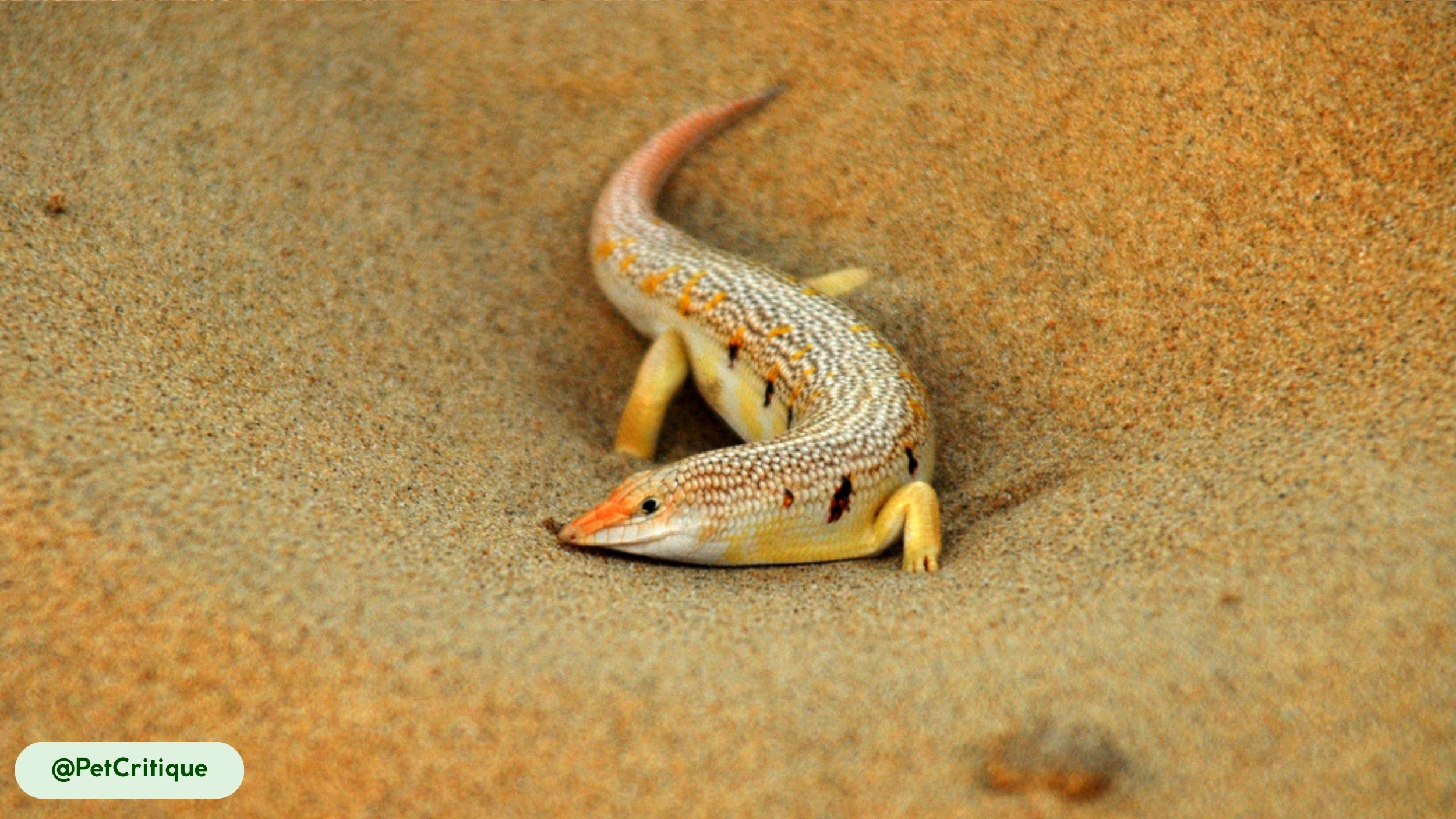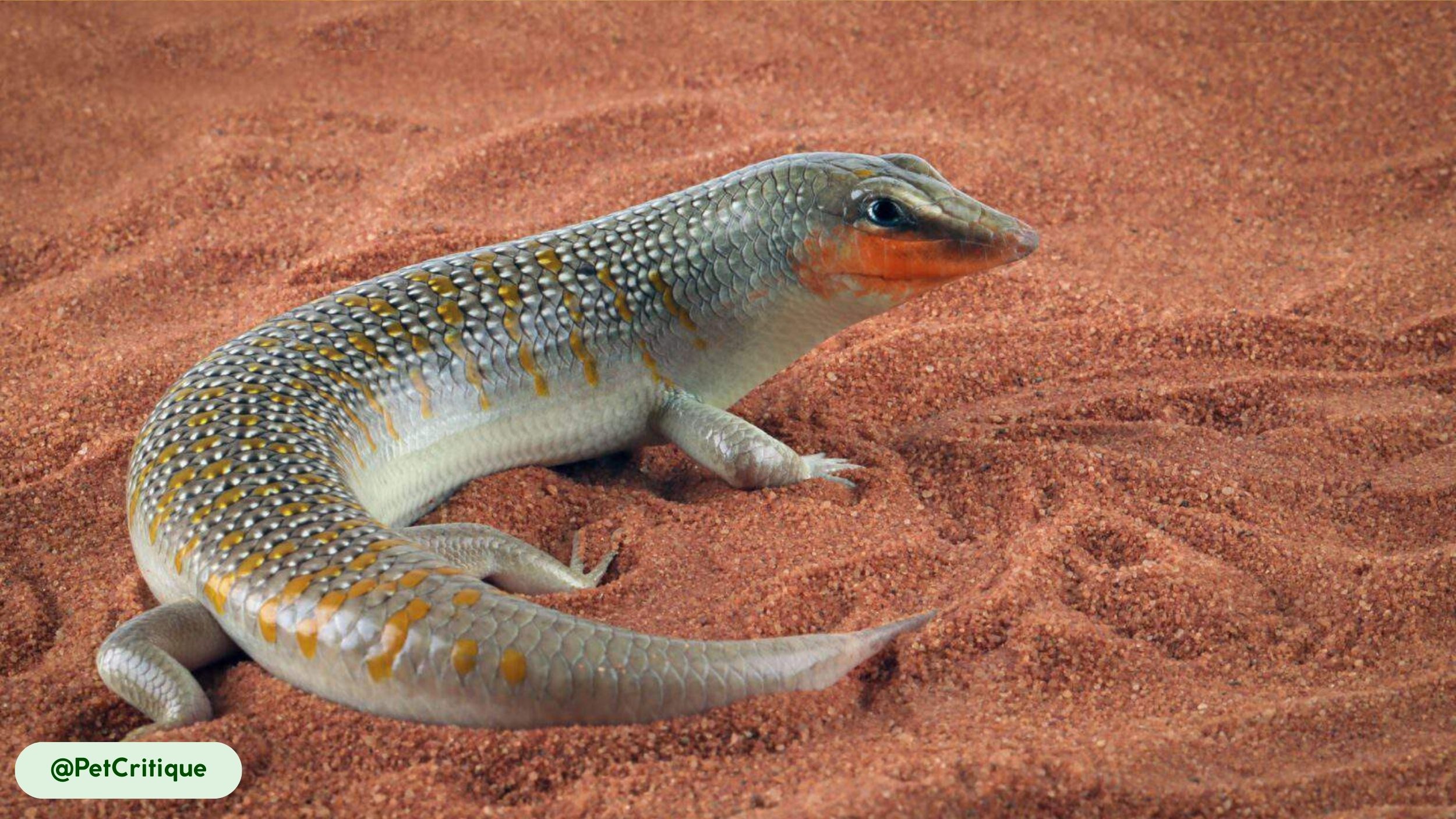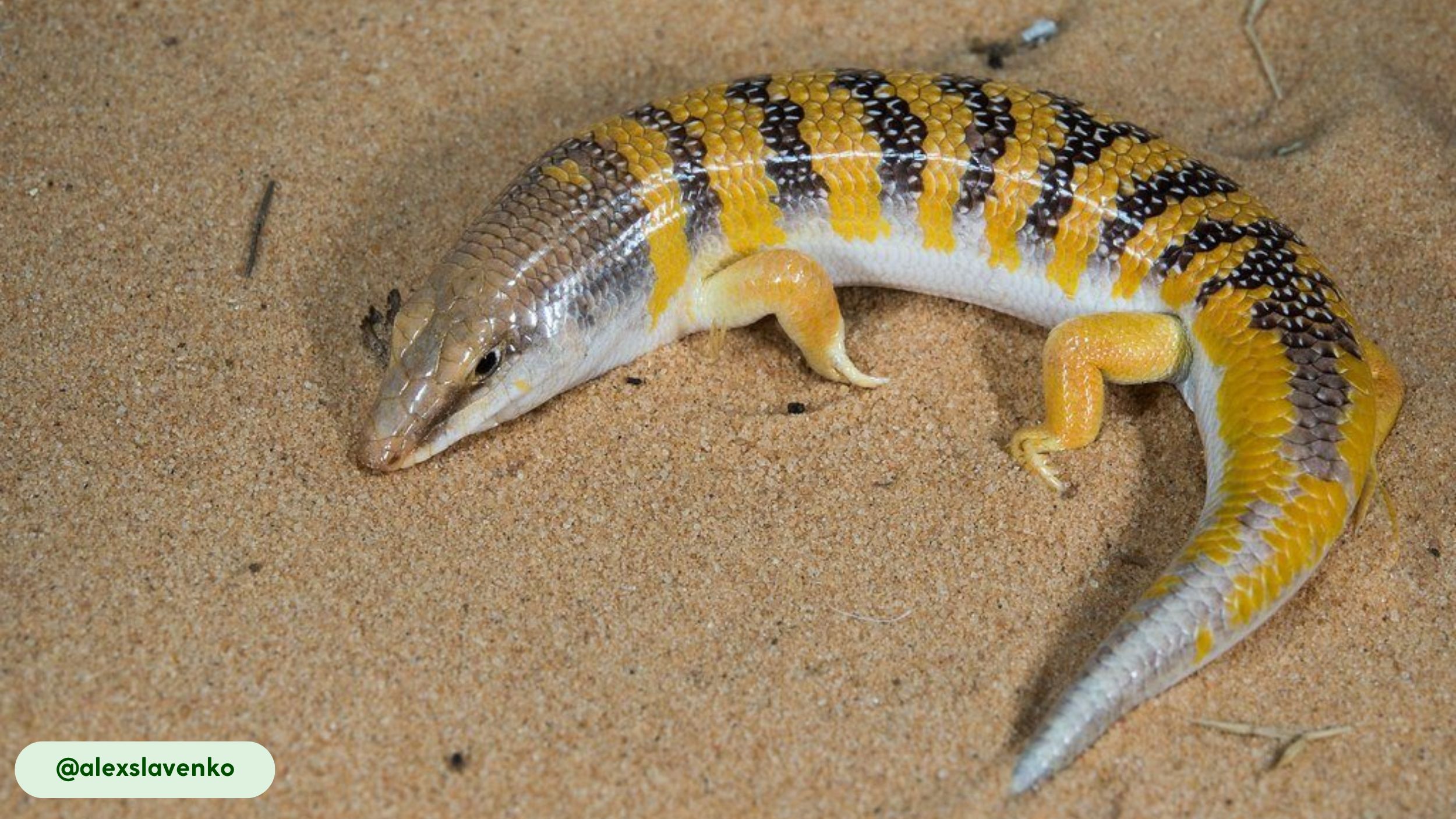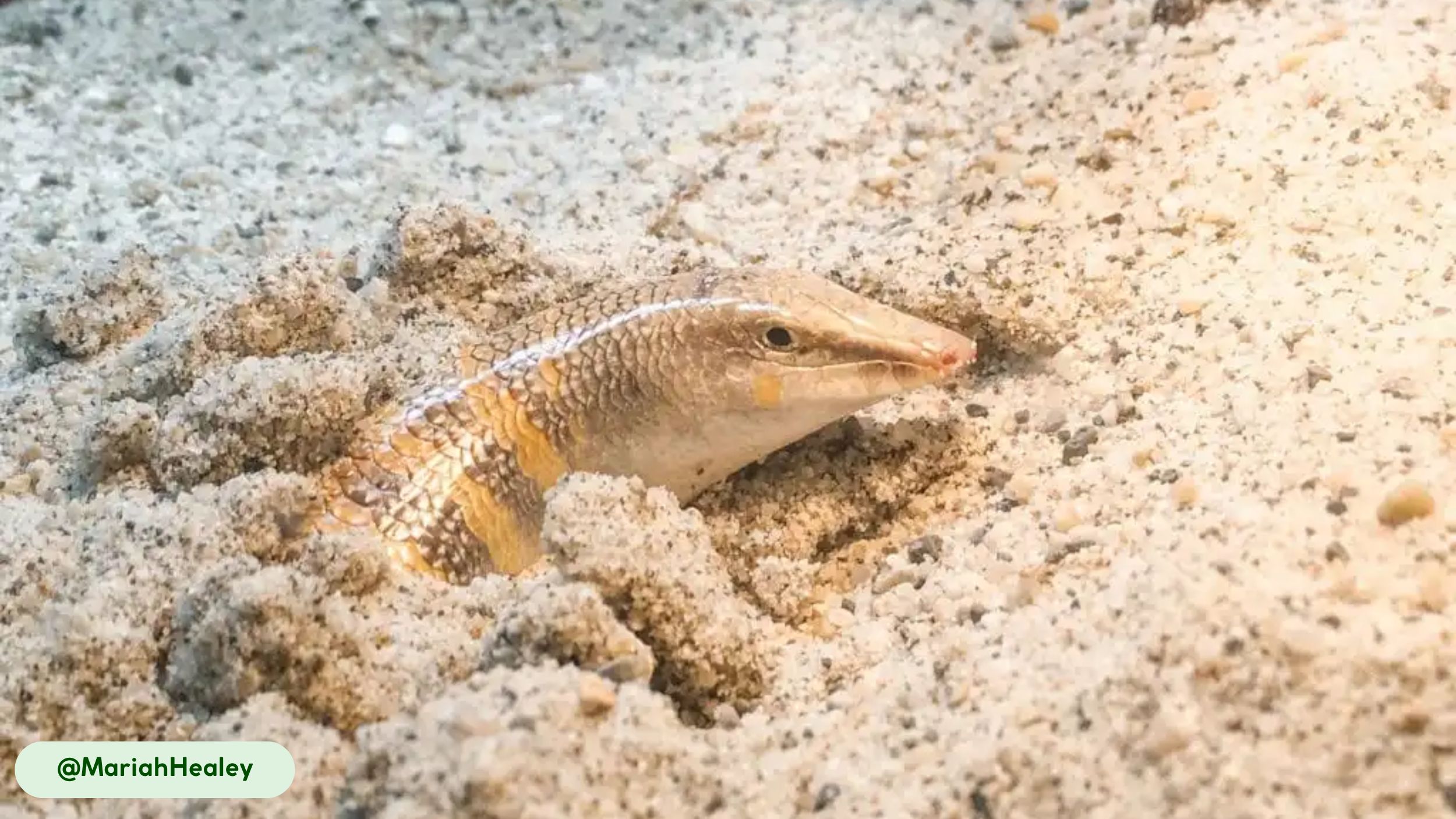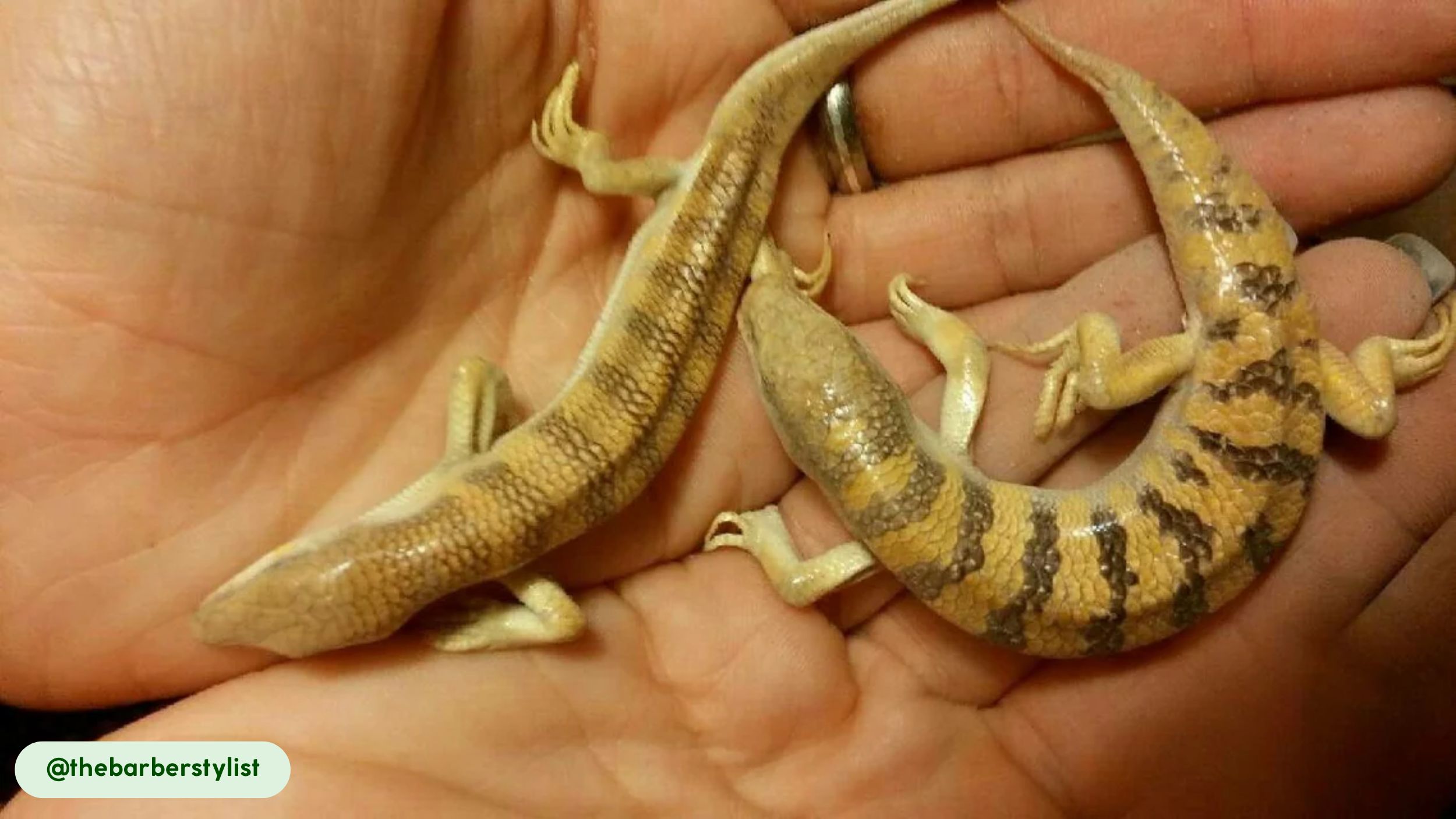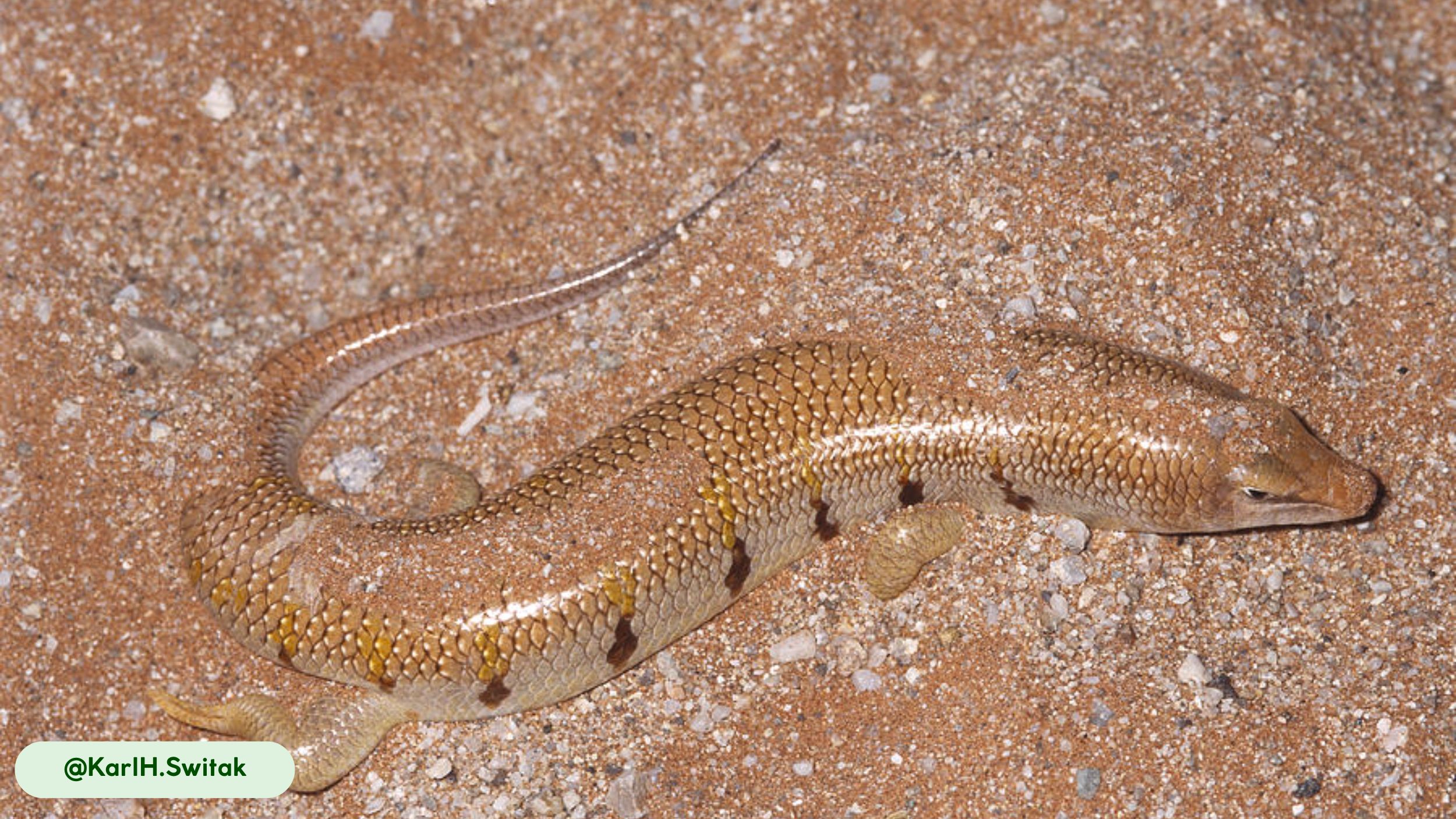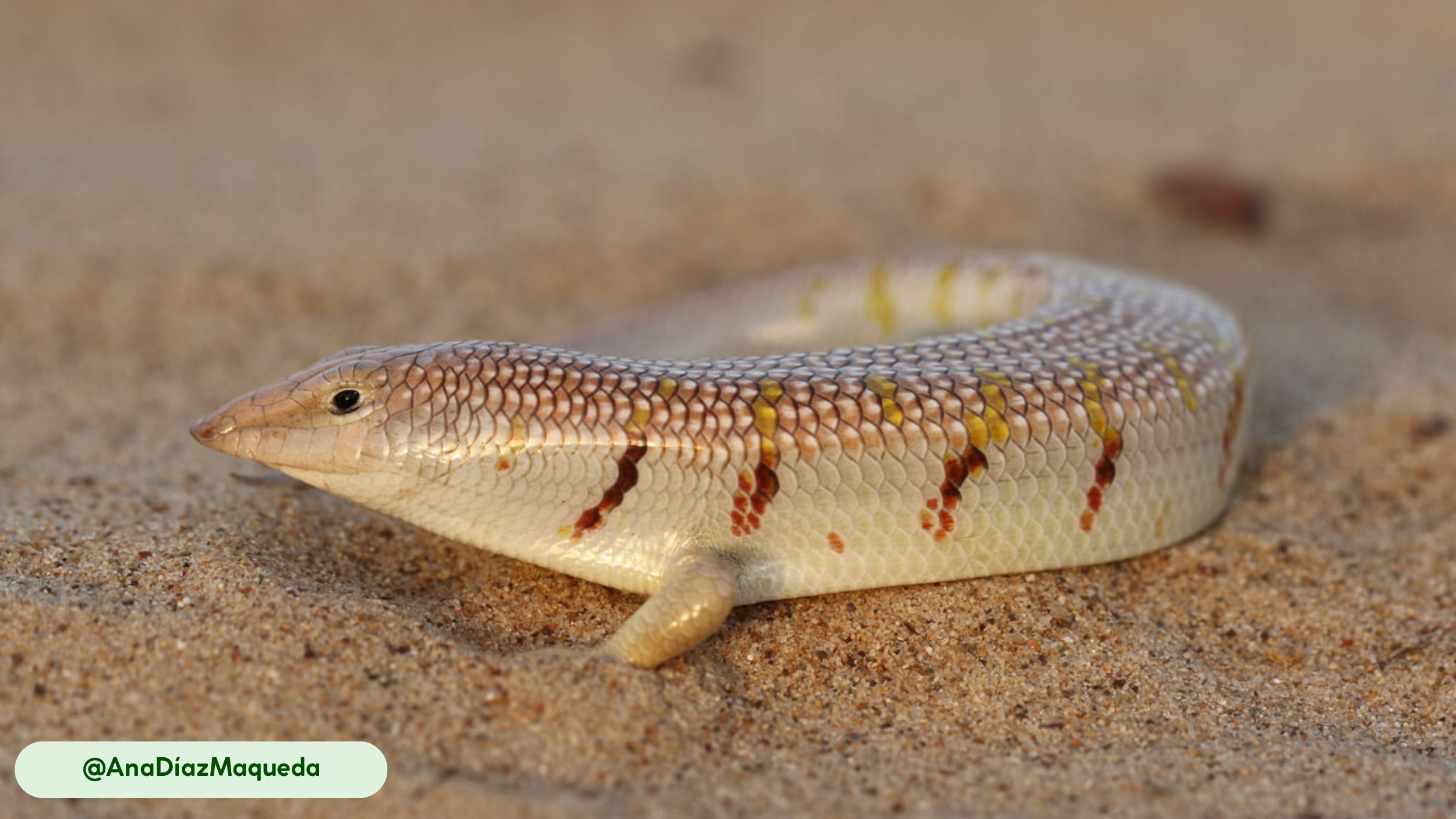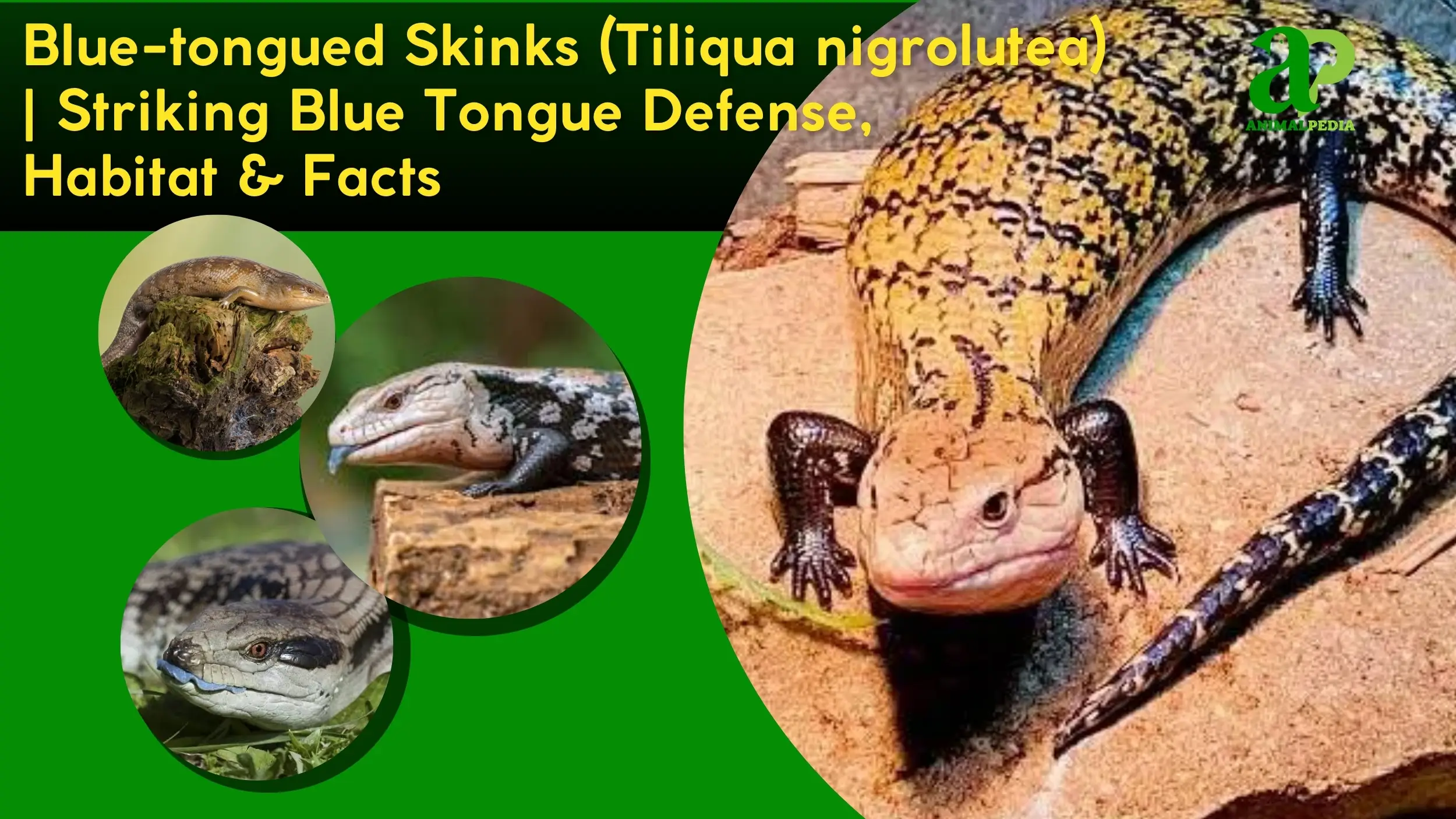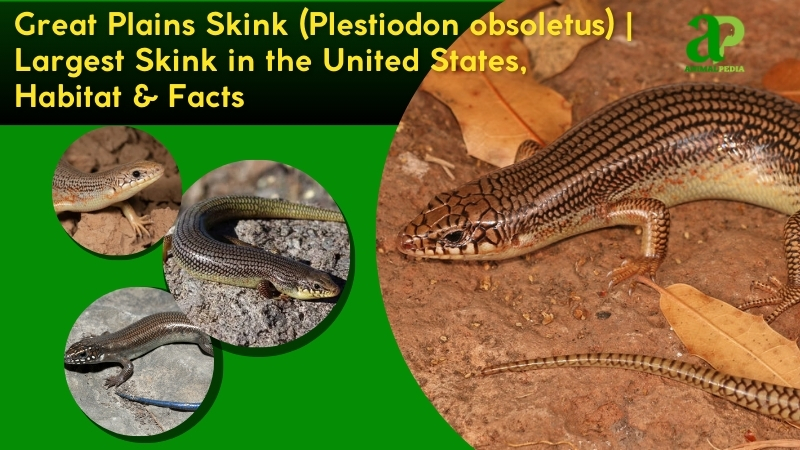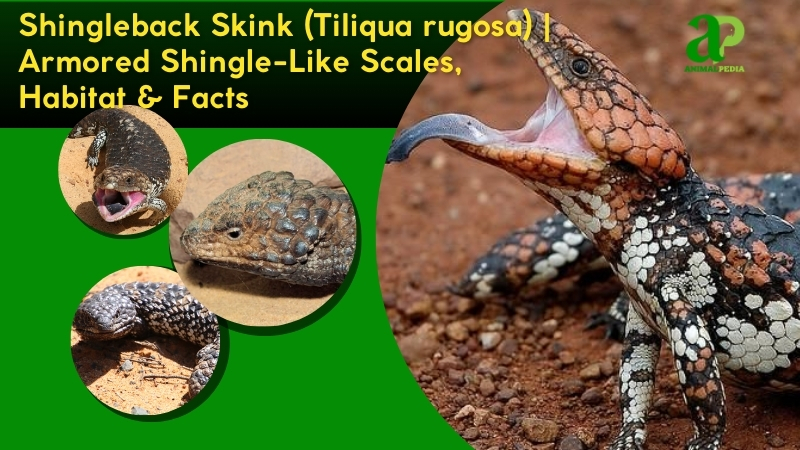Introduction
Sandfish skinks (Scincus scincus) are highly specialized fossorial lizards, renowned for their distinctive ability to “swim” through desert sands [1, 10]. Classified within the class Reptilia, order Squamata, and family Scincidae, these unique reptiles average 7 inches (18 cm) in total length and weigh about 0.59 ounces (16.6 g) as adults [1, 4, 8]. Their geographic distribution spans the arid regions of North Africa and southwestern Asia, including the Sahara Desert and the Arabian Peninsula [2, 5, 9]. These insectivorous creatures primarily consume beetles and ants, demonstrating sophisticated hunting strategies adapted to their sandy domain [1, 5, 10]. Their primary modes of movement involve undulatory sand-swimming, surface running, and stilting, a behavior used for thermoregulation [1, 4, 8]. They are diurnal, perfectly adapted to extreme desert temperatures, and currently hold a “Least Concern” conservation status [1, 6].
This comprehensive guide examines the sandfish skink’s unique physiological and behavioral adaptations, habitat preferences, ecological role, and conservation status. Readers will gain insight into how this species thrives in one of Earth’s most challenging environments, from its specialized respiration system to its remarkable thermal tolerance. Understanding these foundational aspects begins with defining what a sandfish skink truly represents within the vast world of reptiles, offering an unparalleled look into its natural history and scientific significance.
Ready to dive deeper into the world of this fascinating desert dweller? Continue to discover the precise classification and unique identity of the sandfish skink.
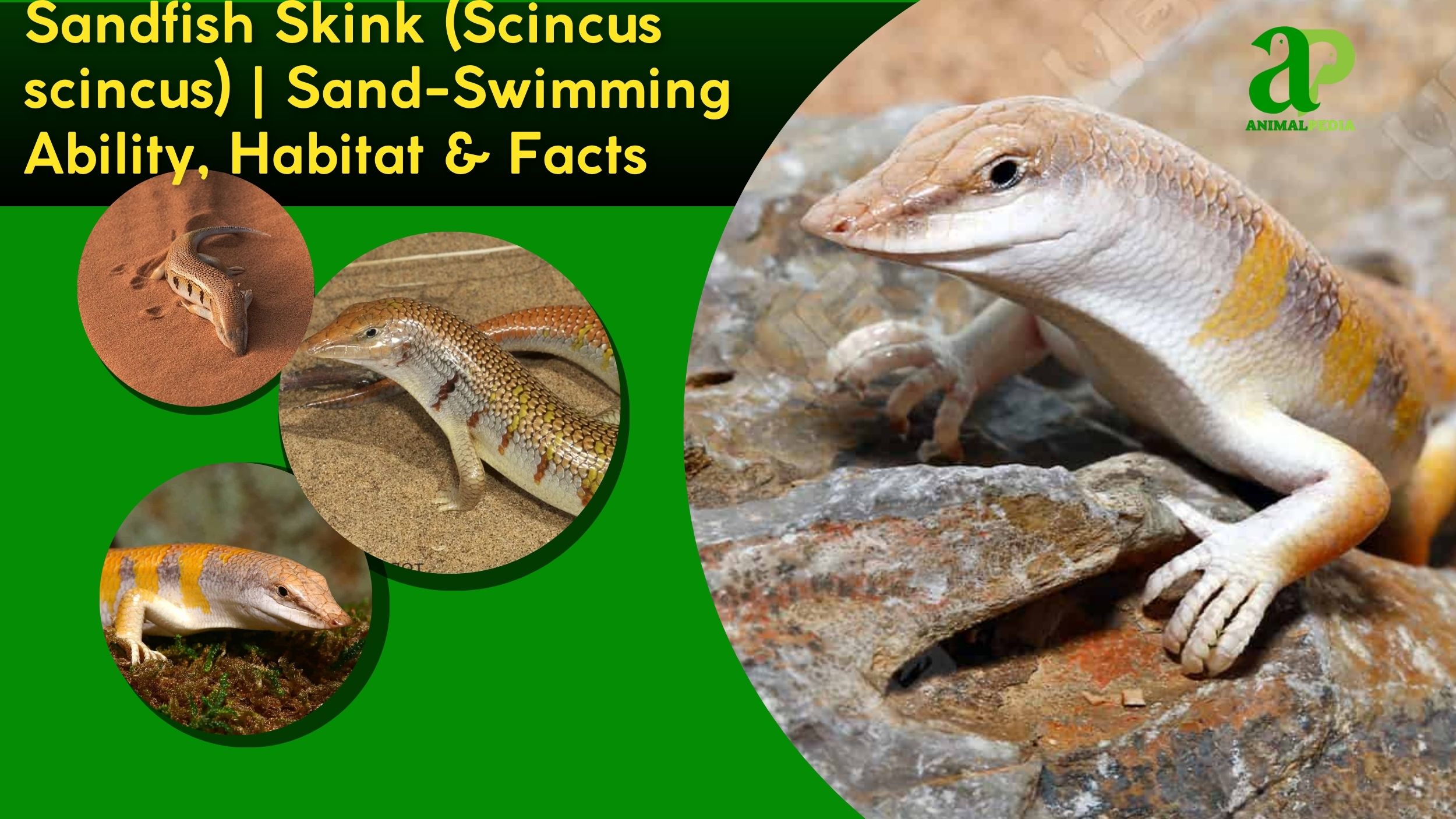
What Is Sandfish Skink?
The sandfish skink, Scincus scincus, is a desert-dwelling lizard found across North Africa and southwestern Asia, distinguished by its remarkable ability to move beneath the sand’s surface as if swimming [1, 10]. This species belongs to the kingdom Animalia, phylum Chordata, class Reptilia, and order Squamata, specifically within the family Scincidae, a diverse group of lizards [1, 3, 9]. Its scientific name, Scincus scincus, derives from the ancient Greek “skinkos,” referring to an African and Eastern lizard historically utilized in traditional medicine [4]. Alternative common names include the common sandfish, common skink, Algerian sandfish, and in German, Apothekerskink, reflecting historical medicinal applications [1, 2, 4].
While this reptile exhibits a clear identity, some aspects present nuanced discussions. Research on sexual dimorphism reports significant size differences where males are often larger in some Algerian populations, likely due to sexual selection, yet other general overviews indicate no clear external dimorphism, attributing variations to regional ecological factors rather than universal traits [2, 5, 9]. The primary function of its distinctive sand-swimming gait also generates discussion: some studies emphasize its role in predator evasion and thermoregulation, while others focus on its energy-efficient hunting capabilities, without a consensus on the exact evolutionary drivers [1, 4]. This distinct identity and the nuances of its observed traits prepare for an exploration of its physical attributes.
Understanding its classification sets the stage for appreciating its physical form. Explore the unique anatomical features that enable the sandfish skink to thrive in its challenging desert home.

What Does Sandfish Skink Look Like?
The sandfish skink presents a compact, tapered, and flattened physique, meticulously adapted for its fossorial existence, showcasing a wide, streamlined form that facilitates efficient sand penetration [1, 4, 7]. Its skin is covered by smooth, shiny, overlapping scales, which are both abrasion-resistant and provide a sandpaper-like texture, serving as effective camouflage and reducing friction during burrowing [1, 2, 4]. The typical coloration features a yellow-caramel hue with irregular brown-black crossbands, providing blending with desert environments; specialized nanostructures on its scales further minimize drag during subsurface locomotion [1, 7, 8].
This species exhibits six primary distinctive features that contribute to its specialized desert survival. These include its wedge-shaped head, small bead-like eyes, slit-like nostrils, a shovel-like mouth, short sturdy limbs with fringed toes, and a short tapering tail. Each of these anatomical components plays a vital role in its ability to navigate and thrive in sandy habitats.
- Wedge-shaped Head: The head is conical and wedge-shaped, featuring a countersunk lower jaw that creates a streamlined profile, essential for efficient burrowing through loose sand [1, 4]. This design allows it to quickly penetrate the substrate.
- Bead-like Eyes: Its small, bead-like eyes, typically black or dark with round pupils, are protected by a transparent nictitating membrane [1, 2]. This specialized eyelid shields the eyes from abrasive sand particles while maintaining visual acuity.
- Slit-like Nostrils: The nostrils are small and slit-like, structured with internal valves and countersunk openings to prevent sand entry during submersion [1, 8]. This adaptation is crucial for maintaining respiratory function in its sandy habitat.
- Shovel-like Mouth: Possessing a short snout and a trowel-shaped mouth, the sandfish skink uses its robust jaw not only for digging but also for effectively grasping and crushing small insects, its primary food source [1, 4].
- Fringed Limbs: Its four short, sturdy limbs terminate in long, flattened, fringed toes adorned with expanded lamellae, functioning like shovels for powerful sand propulsion and burrowing [1, 4, 7]. The hind limbs are notably longer than the forelimbs, contributing to its burrowing efficiency.
- Tapering Tail: The short, cylindrical tail, constituting approximately 20-30% of its total body length, provides balance during surface movements and serves as a significant site for fat storage, a critical energy reserve in its arid environment [1, 2].
Regarding sexual dimorphism in physical appearance, males may exhibit slightly larger heads and overall size in certain North African populations, likely linked to territorial competition [2, 5]. However, no distinct coloration differences have been observed between the sexes [6, 10].
Now that you have a clear picture of its physical attributes, delve into the precise measurements of the sandfish skink. Discover how size contributes to its agility and survival in the shifting sands.

How Big is the Sandfish Skink?
Adult sandfish skinks typically measure an average of 7 inches (18 cm) in total length and weigh approximately 0.59 ounces (16.6 g) [1, 2, 7]. These measurements represent a modest size, comparable to that of a common pencil or a standard smartphone, facilitating their specialized fossorial lifestyle.
| Characteristic | Male | Female |
| Length (SVL) | Up to 4 inches (10 cm) | Up to 3.5 inches (9 cm) |
| Weight | Slightly heavier (variable) | Slightly lighter (variable) |
| Record Size | No specific record data | No specific record data |
Newborns are viviparous, meaning live-born, measuring 2 to 2.8 inches (5-7 cm) and weighing 0.07 to 0.14 ounces (2-4 g) [1, 2]. Juveniles grow to 4 to 6 inches (10-15 cm) by 6 to 12 months, reaching full adult size and reproductive maturity within 1 to 2 years [1, 7].
Having examined its size, it is time to understand where these remarkable creatures call home. Explore the specific arid landscapes and climate conditions that define the sandfish skink’s natural habitat.
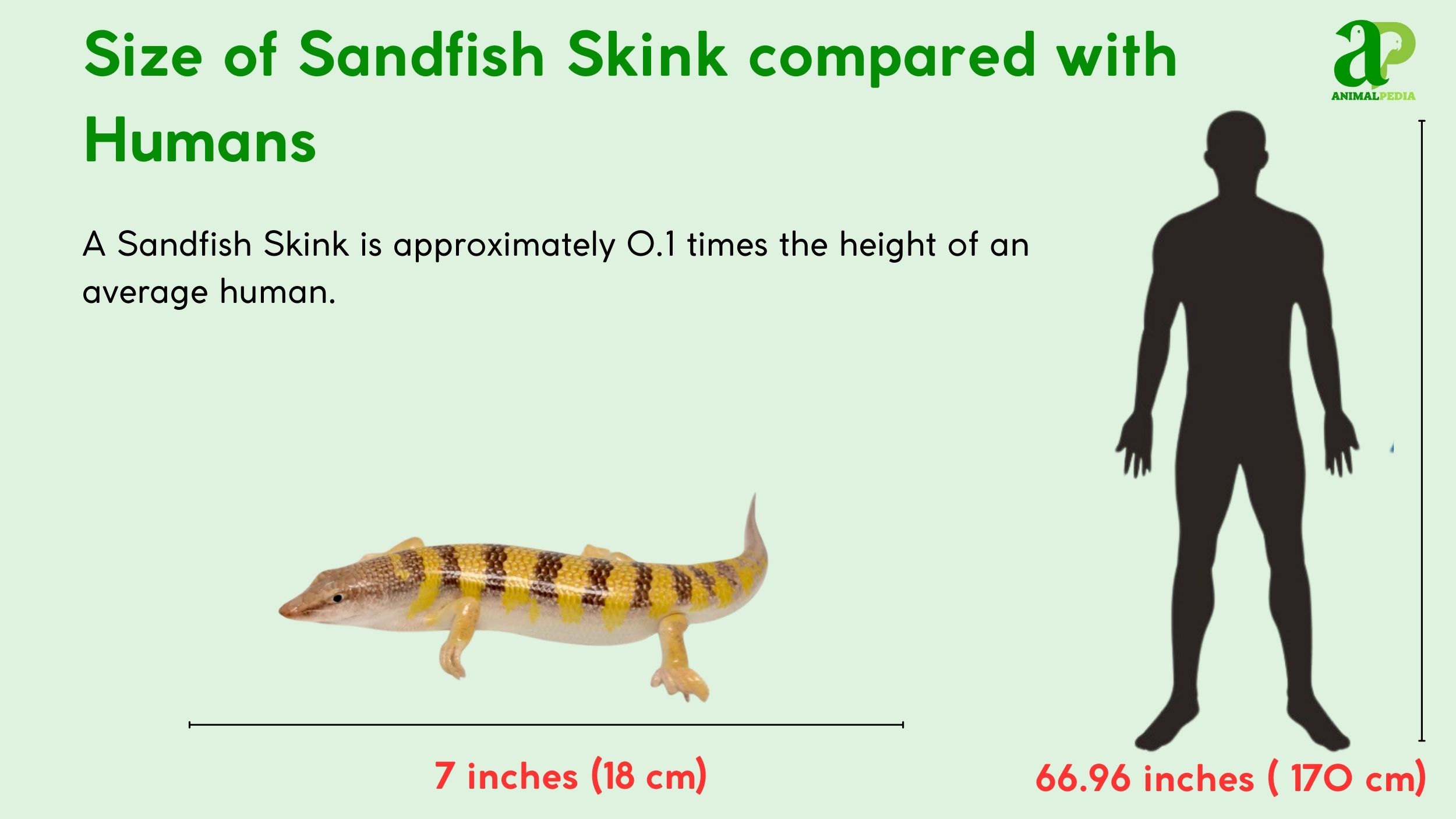
Where Does Sandfish Skink Live?
The sandfish skink inhabits arid sandy deserts and dunes across a wide geographic range spanning North Africa and southwestern Asia [1, 2, 5]. Its distribution extends from Morocco to Egypt in the Sahara Desert and across the Arabian Peninsula, including Saudi Arabia and the United Arab Emirates [1, 2, 5]. These specialized lizards thrive in environments characterized by daytime temperatures ranging from 79 to 113°F (26 to 45°C), tolerating peaks up to 129°F (54°C), coupled with low humidity, typically below 20%, and minimal annual rainfall, less than 2.8 inches (70 mm) [1, 2, 6]. The species exhibits solitary, non-territorial behavior; it does not engage in scent marking or vocalizations, instead defending its space by rapidly burrowing into the sand to escape perceived threats [1, 5].
With a clear understanding of its habitat, uncover the intricate behaviors that allow the sandfish skink to survive and flourish. Discover its unique feeding strategies, movements, and daily routines that are perfectly adapted to desert life.
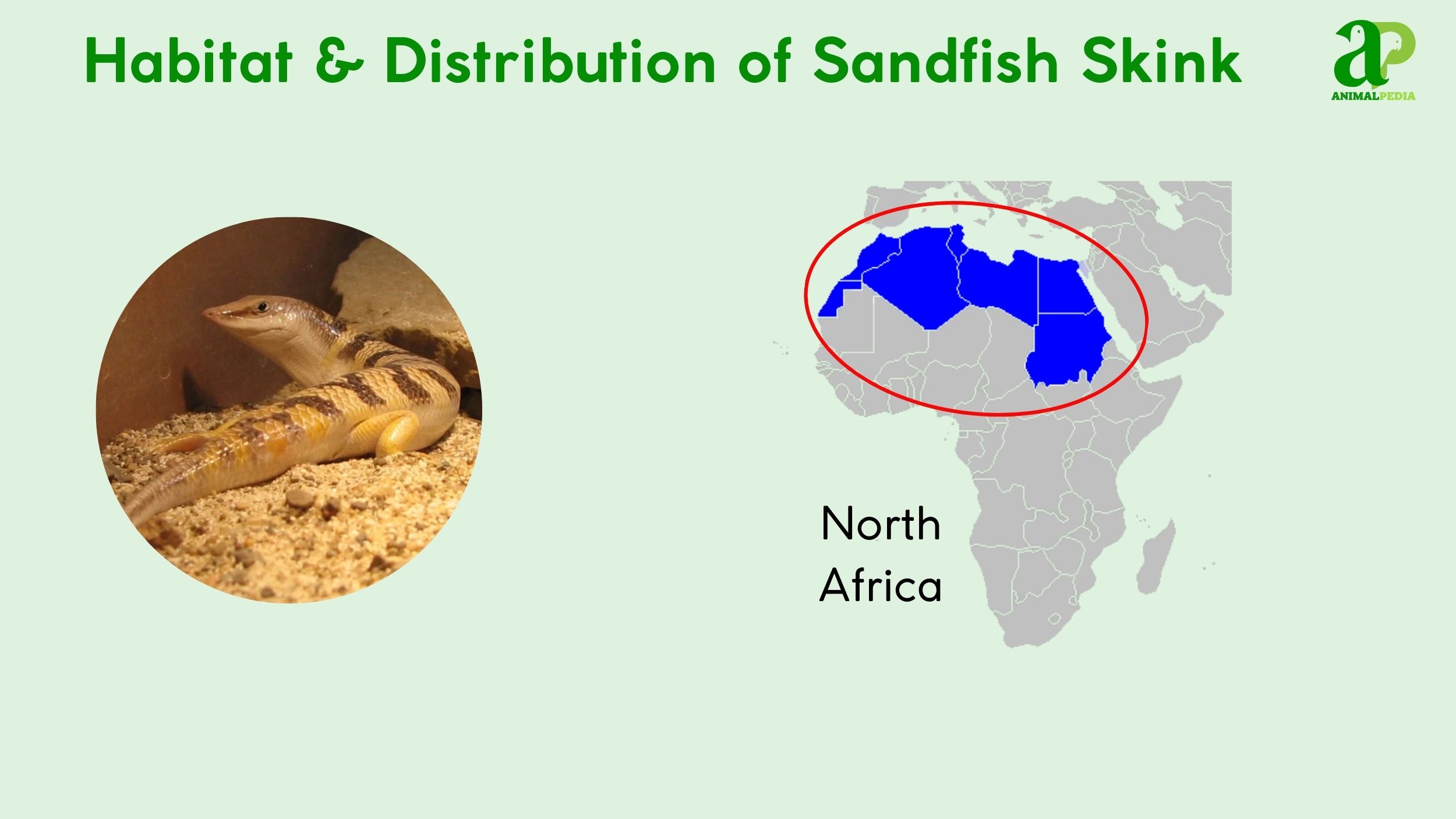
How Does Sandfish Skink Behave?
The sandfish skink exhibits specialized behaviors that allow it to thrive in extreme desert conditions, primarily centered on efficient movement, effective predation, and adaptive physiological regulation. These behaviors represent a finely tuned adaptation to its harsh environment.
- Diet and Feeding: Predominantly insectivorous, consuming beetles and ants through ambush hunting using vibration detection [1, 5, 10].
- Movement and Abilities: Renowned for “sand-swimming” via undulatory body waves, surface running, and stilting for thermal regulation [1, 4, 8].
- Daily/Seasonal Patterns: Primarily diurnal, active during warm daylight hours, with seasonal variations influenced by temperature and rainfall [1, 2, 6].
A closer examination of these behaviors reveals the precise strategies employed by this remarkable reptile.
Diet and Feeding
The sandfish skink, Scincus scincus, primarily eats insects, classifying it as an insectivore or carnivore [1, 5, 10]. Its diet mainly consists of Coleoptera (beetles), accounting for about 62% of its intake, followed by Hymenoptera (ants and wasps) at 13%, with minor consumption of arachnids, approximately 5% [1, 5, 10]. This desert reptile employs an ambush hunting strategy, detecting prey solely through vibration sensed up to 6 inches (15 cm) deep in the sand [1, 8]. It rapidly emerges from the substrate to capture unsuspecting insects, often using its tongue to secure prey [1, 8]. Sandfish skinks typically forage during cooler parts of the day, either early morning or late afternoon, to avoid extreme midday heat [1]. They consume prey whole, with their robust jaws designed for crushing insect exoskeletons [1, 5]. A specialized respiratory tract with internal filters prevents sand inhalation during its subsurface hunting, allowing prolonged breathing in sand pockets [1, 8]. This adaptation highlights its evolutionary refinement for a fossorial existence.
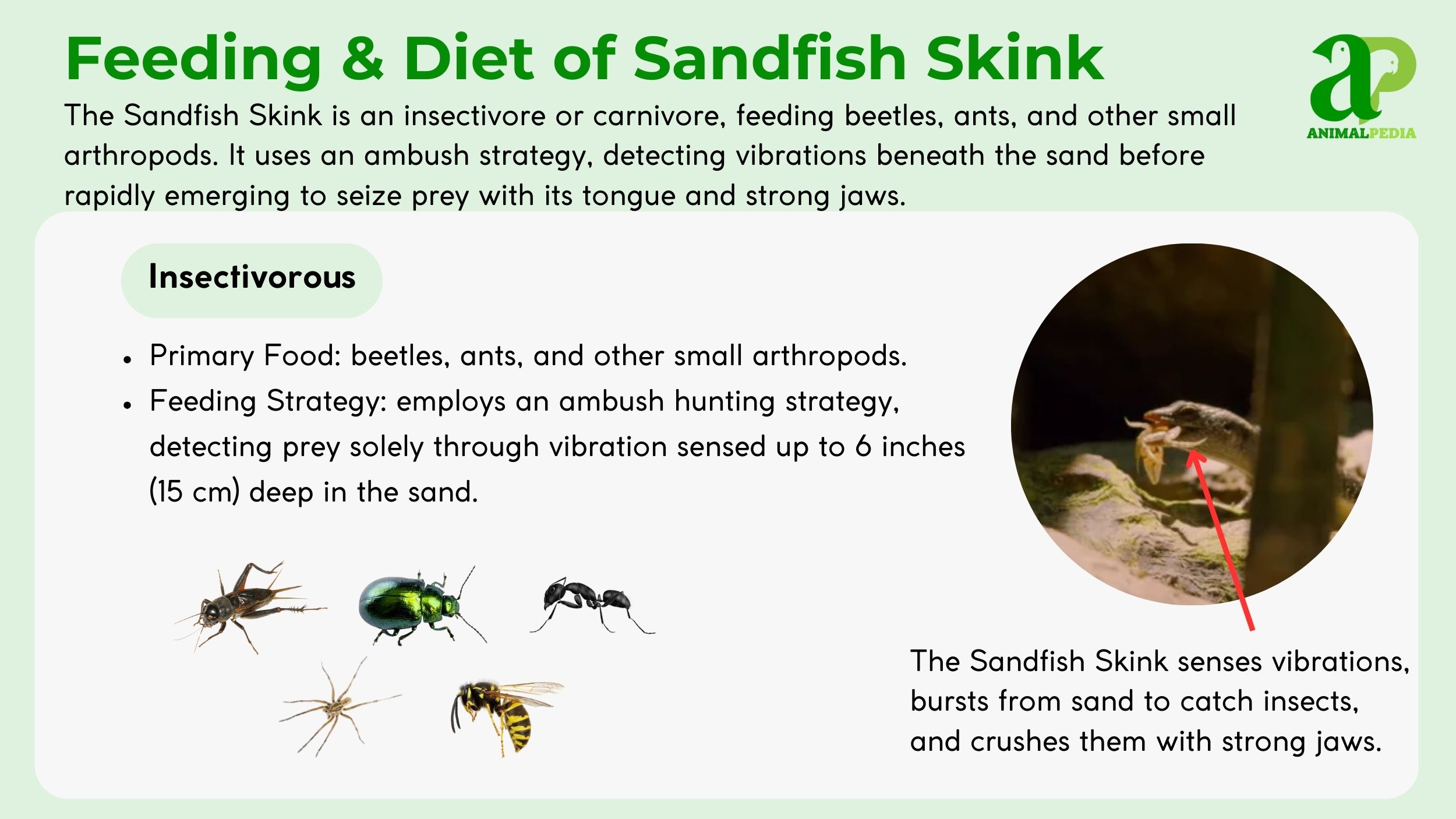
Movement and Abilities
The sandfish skink moves primarily through a unique fossorial “sand swimming” technique, complemented by surface running and specialized stilting [1, 4, 7].
- Sand Swimming: This involves rapid, undulatory body waves that propel the skink through loose sand, mimicking the movement of a fish in water [1, 4, 7]. Its streamlined body and smooth scales significantly reduce friction, allowing swift subsurface travel [1, 7, 8]. X-ray studies show it tucks limbs tight during sand dives for streamlined movement [8].
- Surface Running: When above ground, the skink runs on its short, sturdy limbs, utilizing its long, fringed toes to gain traction on the shifting sand [1, 4].
- Stilting: To regulate body temperature, particularly on hot surfaces, the sandfish skink lifts its body high off the sand using its limbs, creating airflow underneath [1, 7]. This behavior, sometimes described as “dancing” in captivity, aids in cooling [1, 7].
The sandfish skink can achieve burst speeds up to 0.35 miles per hour (0.56 km/h or 16 cm/s) in sand for short durations, typically 10 to 20 seconds [1, 7]. It can sustain slower burrowing over several yards (meters) [1, 7]. Its scales possess microscopic structures that reduce friction by 50%, a trait studied for engineering applications in sandy terrains [1, 7]. Robotic models inspired by its gait are used in search-and-rescue technology [8]. The undulatory swimming uses a 3 Hz frequency, optimized for energy efficiency [7, 8]. The fringed toes with expanded lamellae act as shovels, providing superior propulsion in sand [1, 4]. Its ability to submerge in sand in under a second is a rapid defensive maneuver [1, 7].
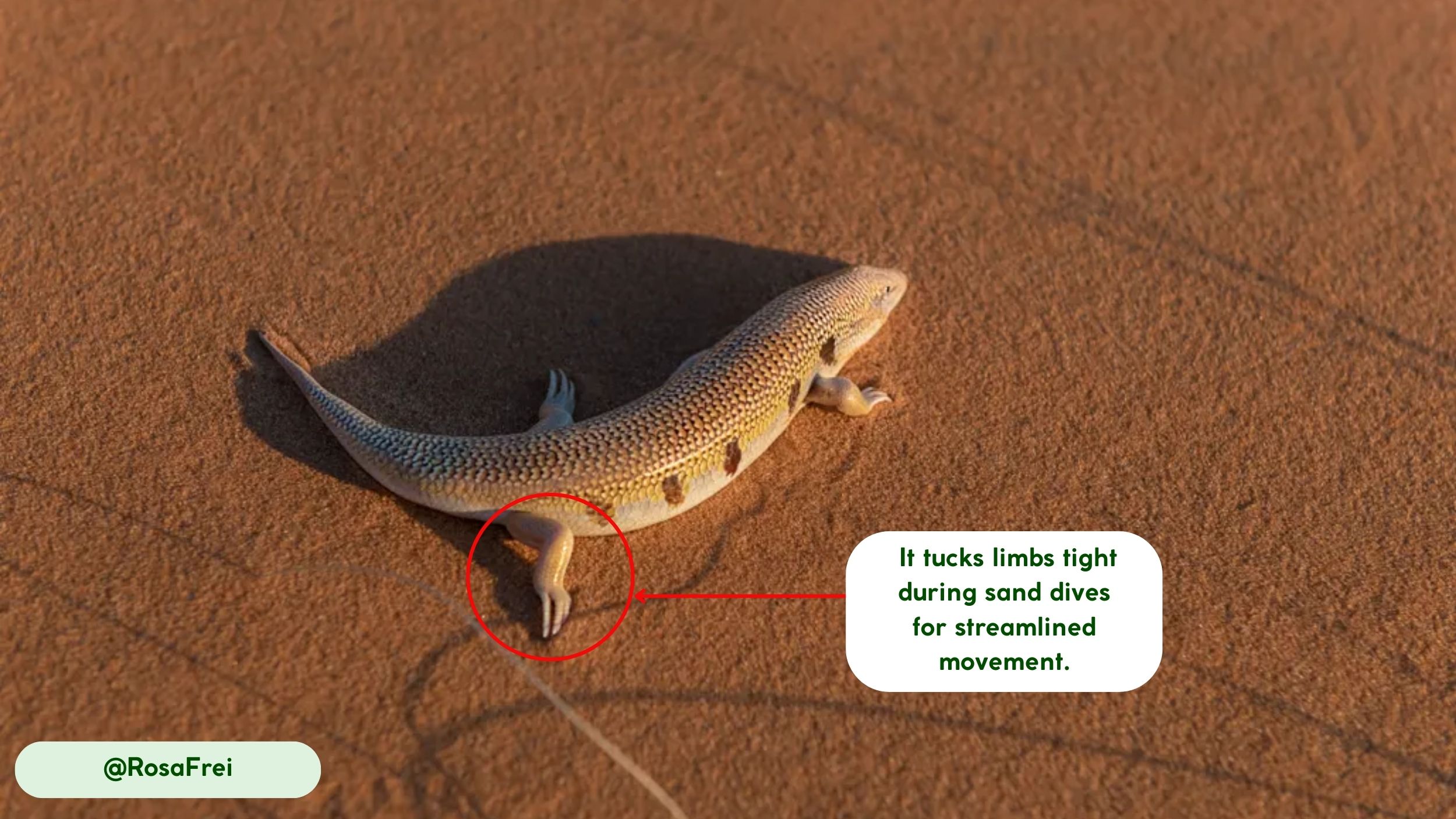
Daily/Seasonal Patterns
The sandfish skink is a diurnal species, active primarily during the daylight hours, with its activity beginning and ending with the sun’s cycle [1, 2].
- Morning (7:00 AM – 10:00 AM): Emerges from the sand to bask in the morning sun, raising its body temperature to optimal levels for activity [1, 6]. It may begin foraging for insects during this period [1].
- Midday (10:00 AM – 3:00 PM): Often retreats beneath the sand to avoid extreme heat, leveraging cooler subsurface layers [1, 6]. This behavior is critical given its tolerance for temperatures up to 129°F (54°C) [6].
- Late Afternoon (3:00 PM – 6:00 PM): Re-emerges to forage more actively as surface temperatures become more favorable [1, 6].
- Nighttime (6:00 PM – 7:00 AM): Remains burrowed in the sand, entering a state of reduced activity for thermoregulation and safety [1].
Sandfish skinks exhibit heightened activity during the warmer, drier months, particularly post-rainy season (May-July), which stimulates insect activity and coincides with their breeding period [1, 2]. During colder winter months, they reduce activity, entering periods of brumation, a reptilian state of inactivity similar to hibernation [1]. This species does not undertake long-distance migrations [1]. Its movements are localized within its sandy desert habitat, primarily focusing on foraging and seeking optimal thermal conditions by shifting between surface and subsurface layers [1, 6].
Beyond its daily and seasonal rhythms, the continuation of any species depends on its ability to reproduce successfully. Next, we explore the unique reproductive strategies of the sandfish skink, a crucial aspect of its life cycle.
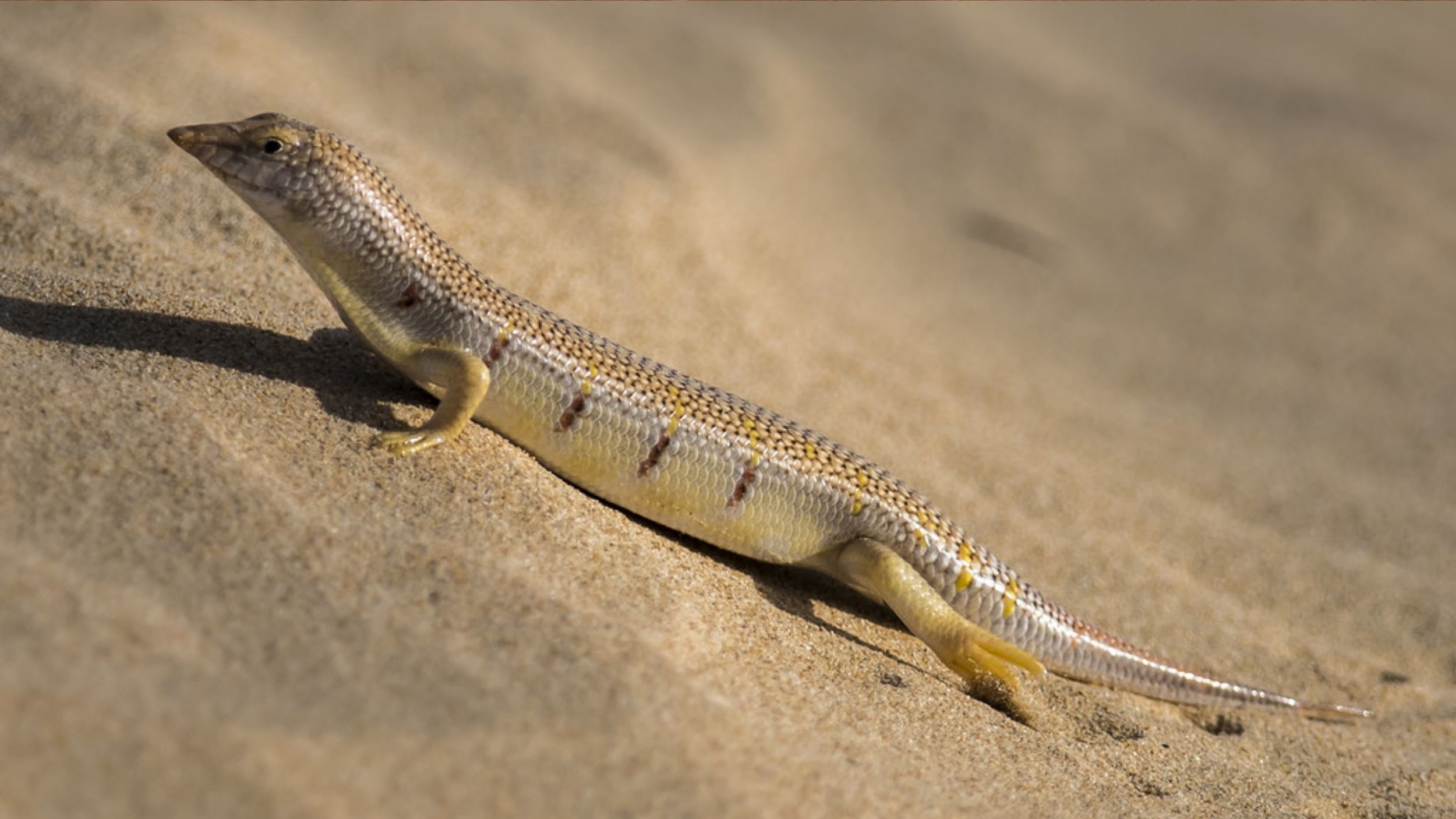
How Does Sandfish Skink Reproduce?
The sandfish skink, Scincus scincus, reproduces through viviparity, meaning females give live birth to fully formed offspring rather than laying eggs [1, 2]. This method of reproduction ensures a higher survival rate for the young in harsh desert environments. The mating season typically occurs during the warmer months, specifically from May to July, often triggered by the seasonal rains that stimulate increased insect activity and provide favorable environmental conditions [1, 2]. Courtship behaviors are minimal, as the species is largely solitary; however, males may exhibit territorial stilting, a behavior where they elevate their bodies, during this breeding period to assert dominance or attract mates [1, 2]. Fertilization is internal, achieved through cloacal contact between the male and female [1, 2]. Following successful mating, the gestation period lasts approximately three months, after which the female gives birth to a litter of 3 to 5 young [1, 2]. Parental care is limited; the female provides protection to the developing offspring internally before birth, but no post-natal care has been observed once the young are born as independent, miniature adults [1].
Understanding how these creatures reproduce naturally leads to questions about their longevity. Discover the typical lifespan of a sandfish skink, both in the wild and under human care, and what factors contribute to how long they live.
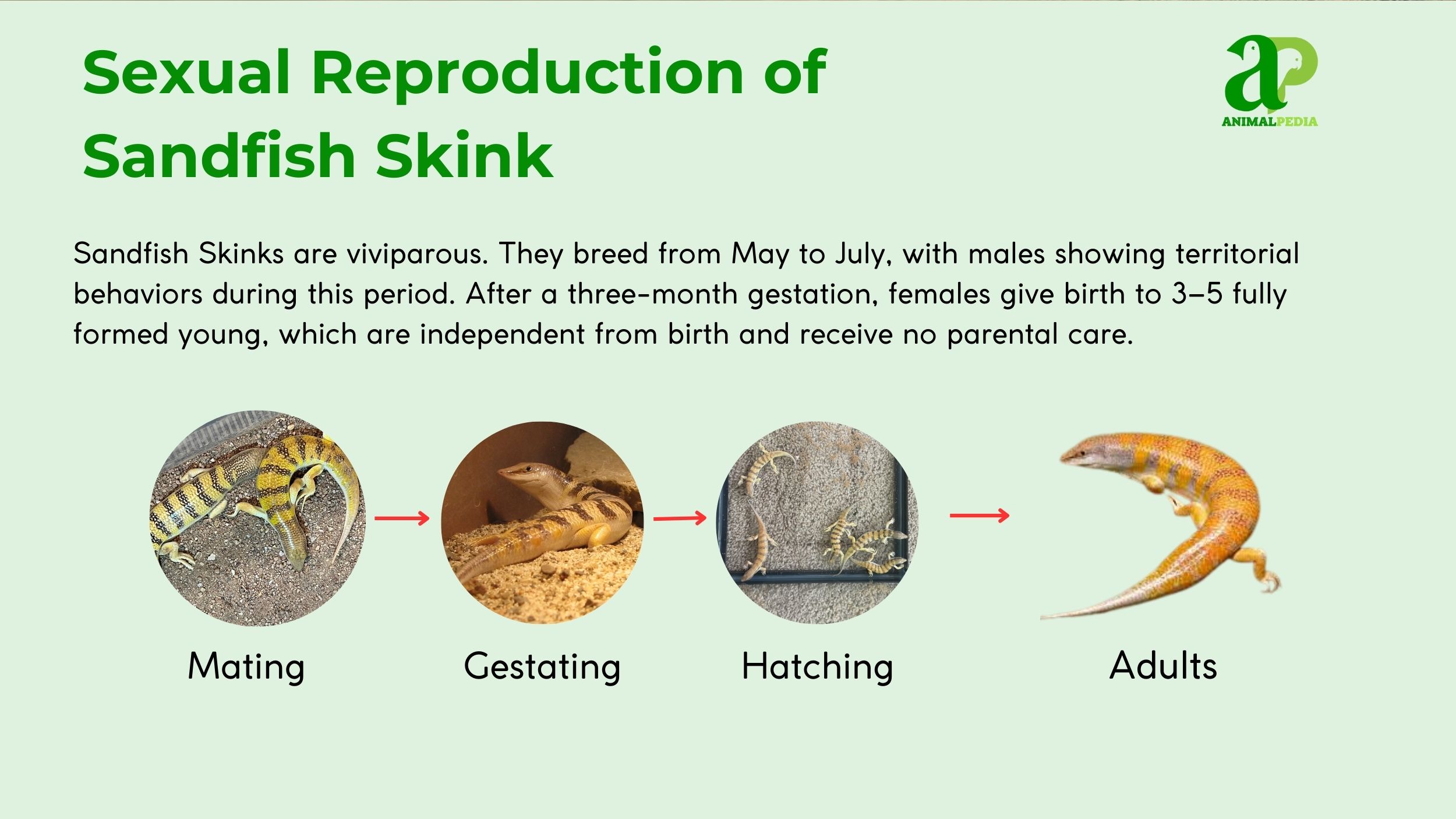
How Long Does Sandfish Skink Live?
The sandfish skink, Scincus scincus, lives 5 to 7 years on average in the wild, with a potential maximum of 8 to 10 years [1, 3, 7]. In captivity, under controlled and optimal conditions, their lifespan generally extends to 6 to 10 years on average, with some individuals living up to 10 years [1, 3, 7, 9]. Sandfish skinks reach sexual maturity between 1 and 2 years of age, at which point they are capable of reproduction [1, 7]. Several factors influence their longevity. A diverse and high-quality insect diet contributes to overall health, while a stable habitat with adequate sand depth for burrowing offers protection from predators and thermal extremes [1, 7, 10]. Predation by desert snakes, birds, and larger lizards significantly impacts wild populations [1]. Additionally, susceptibility to diseases and parasites, such as nematodes, can reduce lifespan [1, 5, 10]. Human impacts, including habitat degradation and overcollection for the pet trade, also pose threats to their survival [7, 10].
Given their remarkable adaptations and existence, consider the role the sandfish skink plays in human interactions. Find out if this unique desert dweller offers any benefits to people.
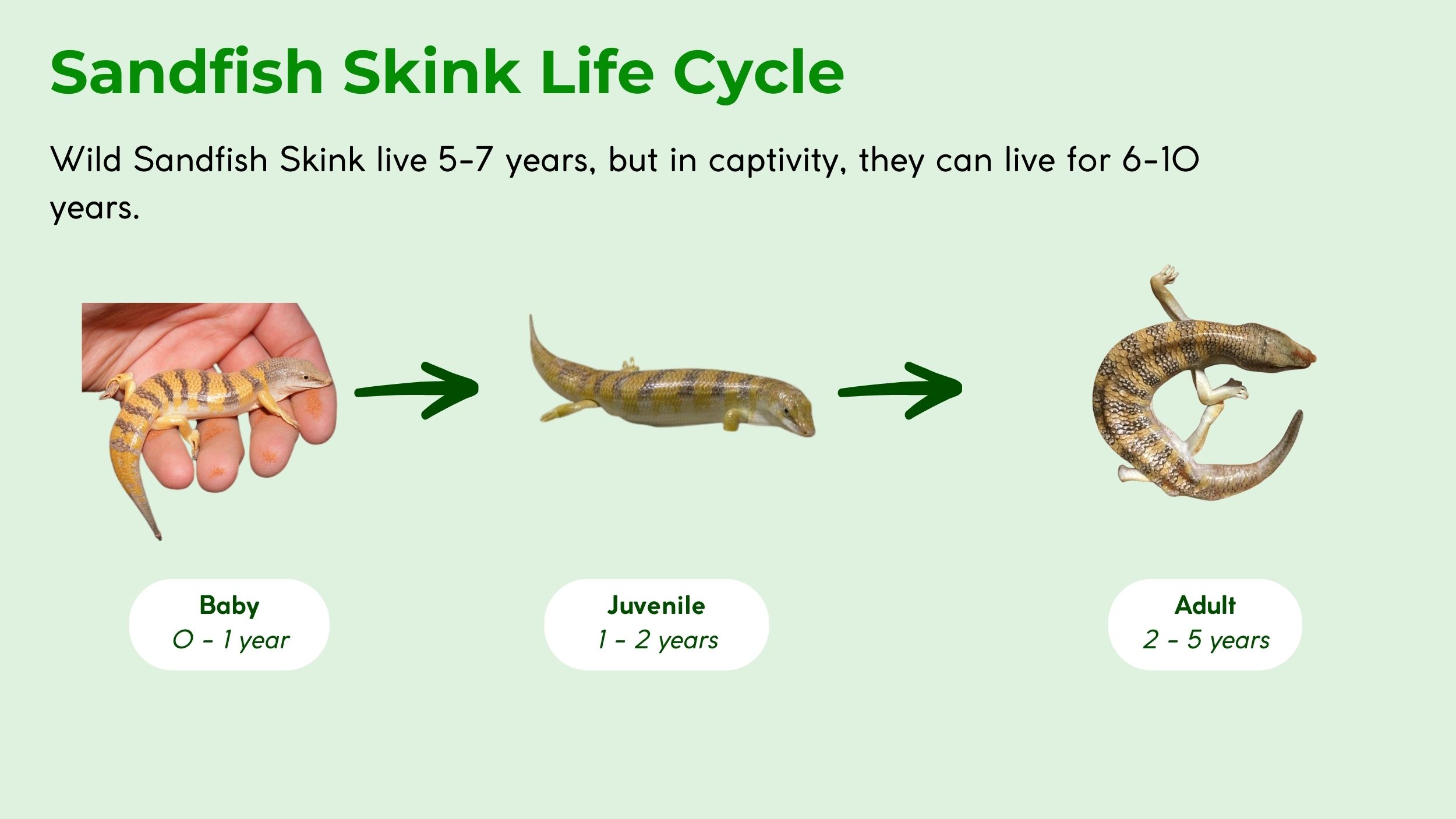
Is Sandfish Skink Beneficial to Humans?
The sandfish skink is beneficial to humans, primarily through its role in pest control and, to some extent, as an interesting pet [1, 2, 5, 6, 10]. These reptiles are natural predators of insects, consuming a significant number of beetles and other arthropods, thereby helping to regulate insect populations in their desert ecosystems [1, 5, 10]. While their impact on agricultural pests in oasis regions is minor, their general insectivorous diet contributes positively to local ecological balance [1, 10]. As pets, sandfish skinks are moderately popular among reptile enthusiasts due to their unique sand-swimming behaviors, providing educational and recreational value [2, 6].
The species is generally harmless to humans, being non-venomous and non-aggressive [1, 2]. Rare instances of bites might result in minor scratches or localized bacterial infections, requiring basic wound care like cleaning with soap and water and applying an antiseptic [1].
Considering its interactions with humans, understanding the conservation status of the sandfish skink is important. Discover if this desert specialist faces threats that endanger its continued existence.
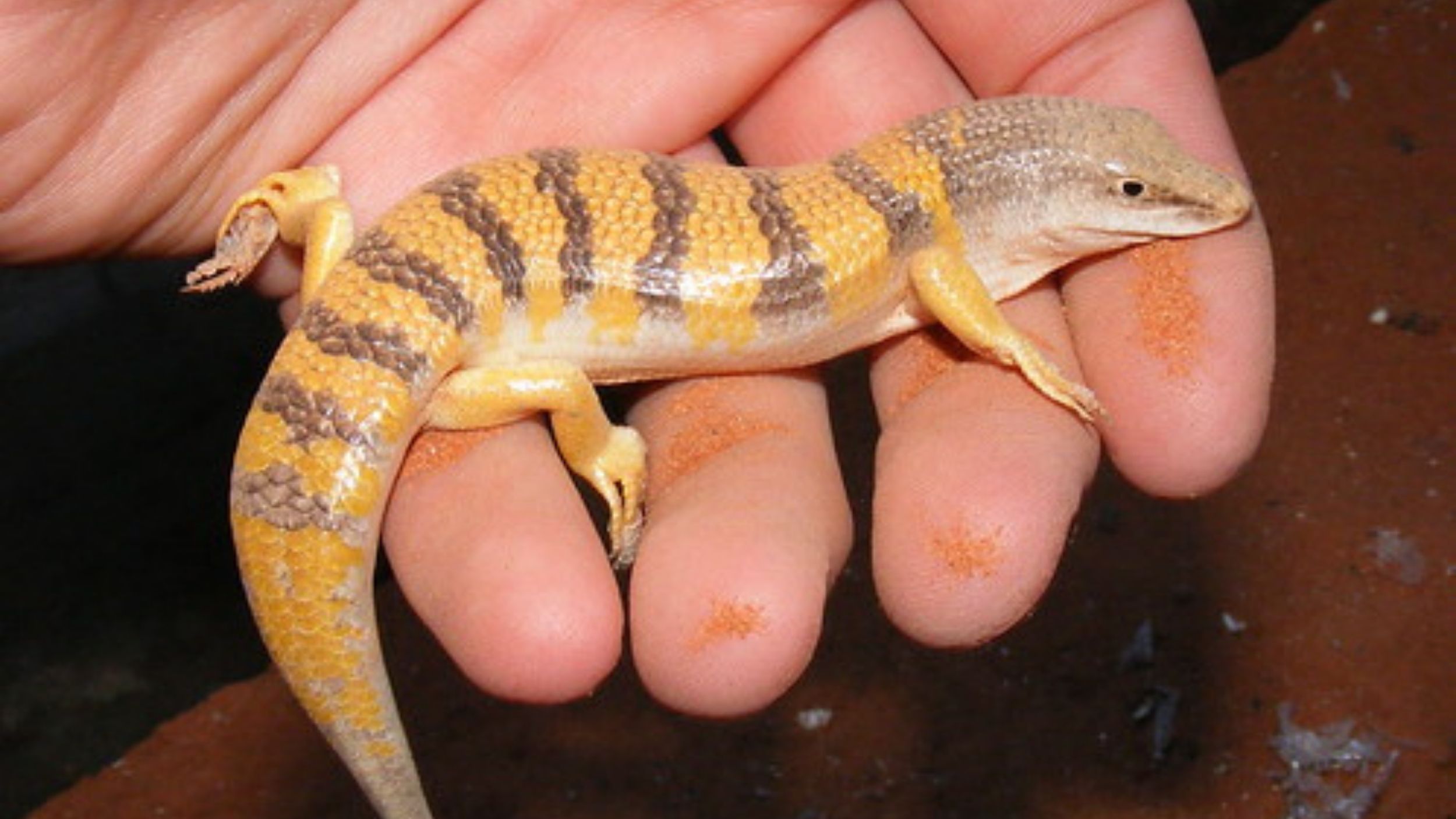
Is Sandfish Skink Endangered?
The sandfish skink, Scincus scincus, is not endangered; its current conservation status is classified as Least Concern by the IUCN Red List, a status confirmed in 2021 and upheld through 2025 assessments [9]. This classification reflects its wide geographic distribution and presumed large, stable populations across North Africa and southwestern Asia [9]. The primary threats to the species include habitat degradation resulting from urbanization and desertification, overcollection for the pet trade, and climate-induced sand shifts [9]. Despite these pressures, the sandfish skink plays a vital ecological role as a pest controller by consuming insects and serves as a prey item for higher desert predators, indicating the health of arid ecosystems [1, 3, 10].
Conservation actions include the species being protected within certain reserves, such as parks in the Algerian Sahara, and ongoing monitoring through IUCN assessments [9]. Breeding programs in zoos contribute to ex-situ conservation efforts, though their primary focus remains on habitat protection and responsible pet trade practices [9]. Individuals can support sandfish skink survival by advocating for habitat preservation and supporting organizations that conduct desert conservation research.
Having explored its conservation status, prepare to be amazed by some truly captivating aspects of the sandfish skink. Uncover a collection of unique facts that highlight its extraordinary adaptations and behaviors.
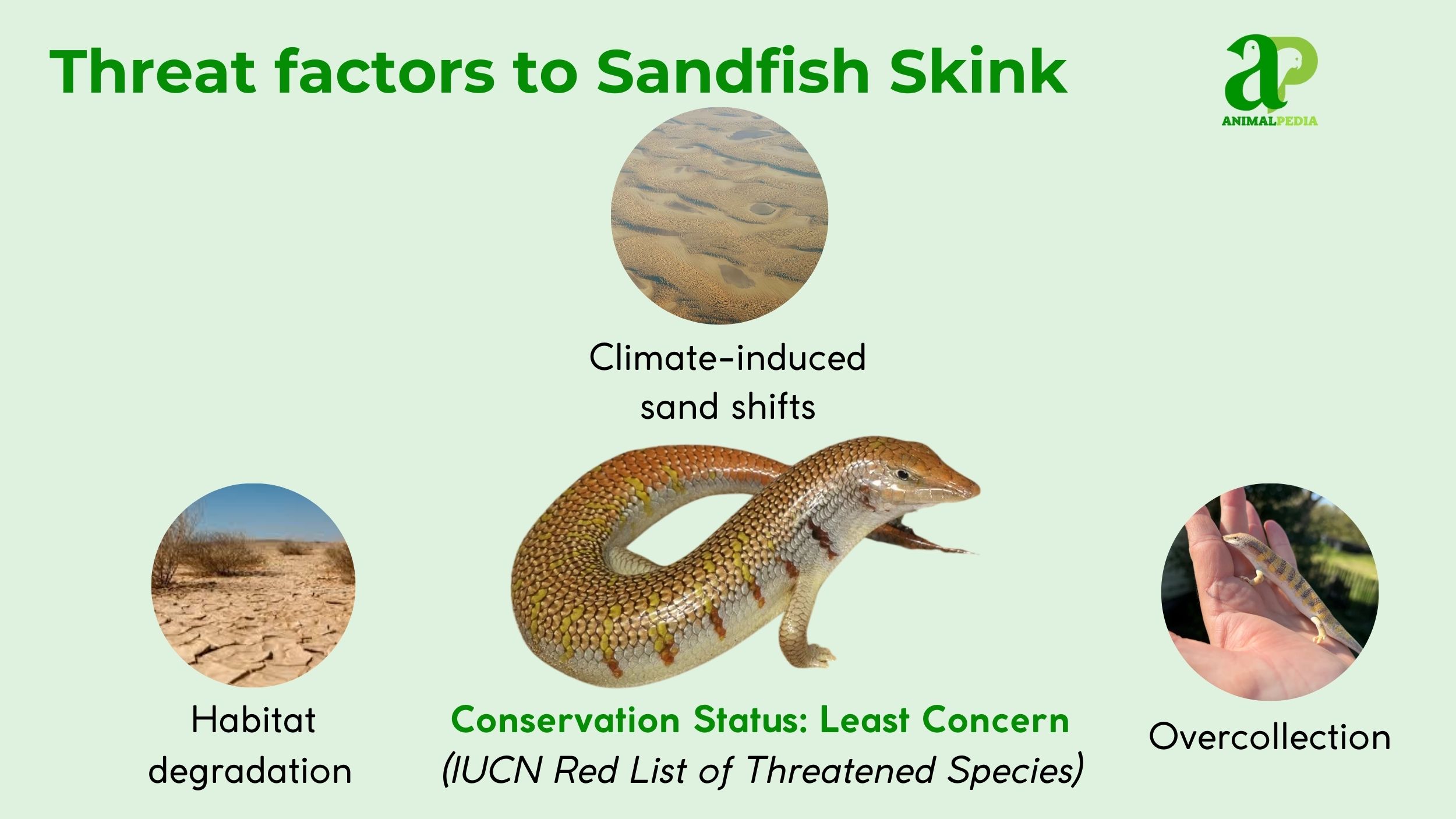
Frequently Asked Questions About Sandfish Skink
Is The Sandfish Skink A Good Beginner Reptile Pet?
Not typically considered ideal for beginners, sandfish skinks demand specialized care, including a deep sand substrate and precise temperature gradients [7]. They thrive with experienced reptile keepers capable of replicating their arid desert habitat successfully.
Do Sandfish Skinks Require Bathing Or Misting?
No, sandfish skinks originate from arid deserts and thrive in low humidity, ideally between 20-30% [7]. Bathing or misting is unnecessary and can cause respiratory issues in this species, which is naturally adapted to dry conditions.
How Do Sandfish Skinks Cope With Extreme Temperature Fluctuations Between Day And Night In The Desert?
They cope by burrowing into the sand, which offers critical thermal insulation [1, 6]. During scorching days, they descend into cooler subsurface layers, and at night, they use the sand’s residual warmth to avoid excessive cooling.
Are There Recognized Subspecies Of Sandfish Skinks In Different Desert Regions?
While some regional variations in morphology and genetics have been observed, particularly in Algerian and Egyptian populations, formal subspecies designations for Scincus scincus are not widely recognized within current taxonomy [2, 5].
These answers clarify common curiosities about the sandfish skink. For an even broader understanding of this and other incredible creatures, Animal Pedia offers a wealth of expertly curated information.
Conclusion
The sandfish skink (Scincus scincus) stands as a remarkable testament to evolutionary adaptation, showcasing unique physiological and behavioral strategies for thriving in some of Earth’s most challenging desert environments. From its specialized sand-swimming locomotion and friction-reducing scales to its advanced prey detection and extreme thermal tolerance, every aspect of this lizard is finely tuned for survival in its arid home. Understanding these intricate details not only deepens our appreciation for this specific species but also highlights the incredible diversity and resilience of life on our planet.
Animal Pedia is dedicated to providing comprehensive, scientifically accurate, and engaging insights into the animal kingdom. We invite you to continue your exploration of fascinating wildlife by delving into our extensive collection of articles and resources. Uncover more extraordinary creatures and expand your knowledge of Earth’s diverse fauna on Animal Pedia today.


